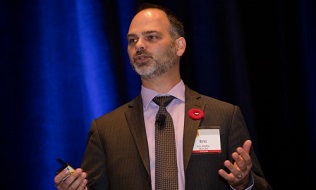

When it comes to workplace wellness, health and wealth must go hand in hand, according to a speaker at the recent Mental Health Summit in Toronto.
Eric Pfeiffer, a senior health management consultant at Manulife Financial Corp., told attendees at the Nov. 7 event that dealing with financial fitness is similar to dealing with mental health. “There’s stigma attached to both,” he said, citing a 2017 study by Manulife, in concert with Homewood Health Inc., that showed emotional barriers, such as shame and embarrassment, make it hard for people to even acknowledge they have a money problem.
Read: Early detection, treatment key to addressing mental disorders
Recent research by Manulife shows financial distress is as big a drag on productivity and employee engagement as mental and physical health. It’s also as rampant. Four in 10 Canadians are financially unwell due to worries about matters such as mortgage payments, college fees and retirement savings, according to the company’s 2016 financial wellness index.
Ninety-seven per cent of the more than 200 counsellors who participated in the Homewood Health-Manulife study agreed that financial challenges have an impact on overall health, well-being and productivity. At the same time, 52 per cent felt recovery from mental or physical ailments takes longer due to the ensuing financial stress.
So, for a wellness program to be holistic, it’s important for employers to cater not just to their employees’ mental and physical well-being but their financial fitness as well.
Read: Why employers stand to gain by helping their employees sleep
So what can employers do? Just like they have protocols to promote mental health and physical well-being at work, there are ways employers can endorse financial fitness as well. According to Pfeiffer, the options include:
- Reassure employees they’re not alone. “Let them know four in 10 Canadians are dealing with the same issue,” said Pfeiffer. “That’ll help combat some of the stigma.”
- Let them know it’s OK. “Being financially unwell doesn’t define them as a person. It just means they have a financial issue they need to address,” said Pfeiffer.
- Tell them they can still get there. “The best time to plant the tree was 20 years ago,” said Pfeiffer. “The next best time is today. You can still do something about it if you start now.”
- Educate them about the different aspects of financial wellness, such as budgeting, saving and establishing financial protections for the short and long term.
- Help them identify their financial risks through a financial wellness assessment. “Aggregate staff results and help direct education toward the biggest issues specific to your workforce,” said Pfeiffer.
- Provide access to the right tools. “Make them aware of your group retirement savings program or pension plan,” said Pfeiffer. “Educate them about the right buffers for them, whether it’s disability or life insurance. Offer them easy access to financial advisors.”
